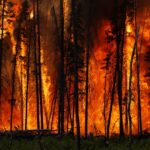The University of Maryland (UMD) held its first Lightning Safety Awareness reporters’ workshop on June 24, 2014, raising awareness about lighting safety both for people and for building structures through multiple presentations, panel discussions, and a Lightning 101 class.
Hosted by UMD’s Earth System Science Interdisciplinary Center (ESSIC), presenters from National Oceanic and Atmospheric Administration’s National Weather Service (NWS), Federal Alliance for Safe Homes (FLASH), Insurance Information Institute, University of Maryland and the Lightning Protection Institute shared information about lightning signatures, insurance policies, and useful statistics for the public to know when faced with a sudden flash.
Scott Rudlosky, a NOAA physical scientist co-located at the ESSIC-administered Cooperative Institute for Climate and Satellites, presented information on how NOAA has developed its algorithms to more carefully predict severe weather effects of a storm through satellite imagery.
“During the late ’80s and early ’90s scientists discovered that intra-cloud (IC) lightning flash rates often increase rapidly immediately before severe weather at the surface,” said Rudlosky. “More recently, researchers have quantified this lightning signature and used it to help identify severe storms.”
Rudlosky said that the algorithm can predict severe weather ~20 minutes ahead of time, with a 79% probability of detection (POD), and a 36% false alarm rate (FAR). By taking the data gathered from the lightning signatures, NWS can more precisely inform the local or regional communities of correct safety procedures to follow.
According to the National Weather Service, lightning can heat the air it passes through to 50,000 degrees Fahrenheit, and there is enough energy in a typical flash of lightning to light a 100-watt incandescent light bulb for about three months or the equivalent compact fluorescent bulb for about a year.
Donna Franklin, NOAA’s Lightning Safety Awareness Team Lead, dispelled the myths associated with lightning strikes, explaining the facts on how to protect against them. In her opinion, Franklin said some of the most dangerous myths about lightning safety involve lightning crouches or standing near trees for protection from the storm.
About 30 percent of lightning victims are found near or under trees, said Franklin, and ground currents account for the deaths of 40 to 50 percent of lightning victims. Further, only three to five percent of lightning victims are directly struck by lightning.
“Once you’re outside, there’s really no safe place and it gives people a false sense of safety,” said Franklin. “What they should be doing is, even if they aren’t near safe shelter, they should make their way to safe shelter.”
According to Kim Loehr, Lightning Protection Institute (LPI) is focused on providing complimentary lightning protection systems for vulnerable fire stations in lightning-risk areas this year.
“That encompasses protection for people, protection for property, understanding why it is important and the importance of lightning,” said Loehr, the communications director for the LPI.
“Indoors isn’t always safe- a third of lightning injuries are indoors,” said Loehr. Loehr said fire departments in the United States respond to an estimated 22,600 lightning fires each year, which are responsible for civilian and firefighter deaths and injuries, and about $451 million in preventable property damage.
Loehr said she was born into the industry through her father’s family business, the Loehr Lightning Protection Company (LLP), which started in 1947. While she majored in journalism in college, Loehr started writing about lightning “pro bono” at work, eventually joining the industry as a writer.
“I think the partners that participated on the panels and the presentations were really outstanding,” said Loehr. “I wish we had more media attend, [but] I think we started a really good relationship with ESSIC and University of Maryland and that we can build on that newly formed partnership to do more.”
“I thought it was a really well-done event, I enjoyed the information,” said Timothy Smail, senior vice president of Engineering and Technical Programs at FLASH. “I thought the information […] wasn’t to the level of detail where one cringes, but enough.”
Smail became involved in lightning protection technology after his mission trip to Picayune, Mississippi, in 2006 to assist in reconstructing damaged homes after Hurricane Katrina. Noticing that the volunteers were rebuilding the homes exactly as they were before the storm, Smail said he wondered if their work was constructive in protecting against future natural disasters.
Smail said the purpose of his not-for-profit organization is to strengthen homes and safeguard families from threatening natural disasters, working directly with consumers and professionals to educate them on better ways to protect themselves.
What’s important to remember, Smail said, is that lightning is looking for the easiest way to the ground; installing lightning protection systems, such as lightning rods on rooftops, gives a lightning strike the easiest way to do so.
“To me the most valuable message was kind of two-fold,” said Smail. “One was how big of a potential threat lightning can be and two is that even though it is a big potential threat, unlike a tornado there are ways you can protect your family and home from a major disaster.”





